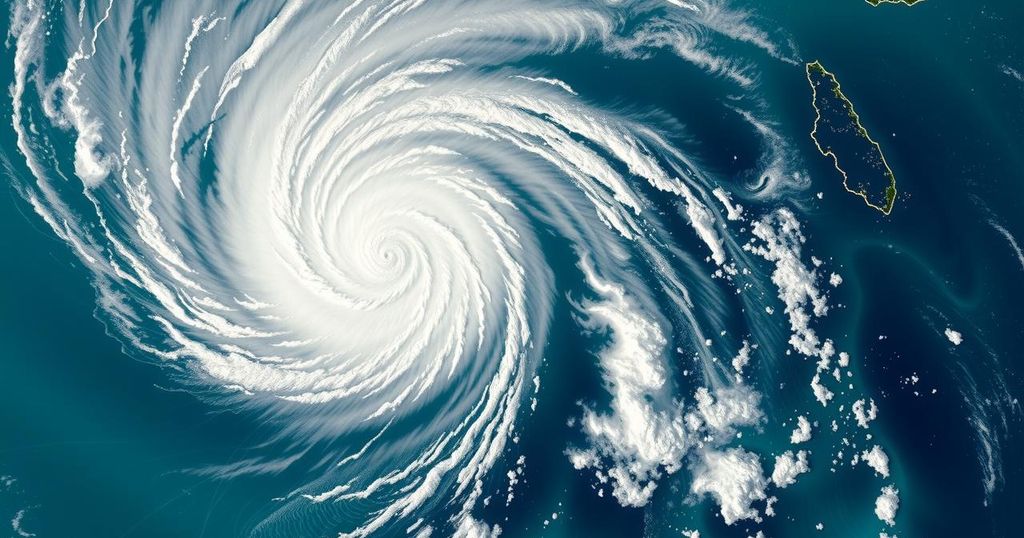Tropical Cyclone Chido: A Historic Devastation in Mayotte
Tropical Cyclone Chido struck Mayotte on December 14, causing catastrophic wind speeds and rainfall. This storm was the strongest in 90 years, prompting national mourning and emergency response efforts. Despite accurate warnings, many lives were lost due to inadequate housing resilience. The cyclone later affected Mozambique and Malawi, while discussions on the role of climate change continue. RSMC forecasts project increased cyclone activity in the coming seasons.
On December 14, Tropical Cyclone Chido struck the small island of Mayotte in the Indian Ocean, reaching wind speeds exceeding 200 km/h, with gusts surpassing 225 km/h. This cyclone was reported to be the most powerful storm to impact Mayotte in nearly nine decades, according to Météo-France. Accompanying the cyclone, torrential rains led to 176 mm of rainfall within a mere 12-hour period, while ocean conditions became perilous, with average wave heights above 5 meters. The storm was so intense that it caused significant damage to Météo-France’s observational facilities.
In response to the devastation, French President Emmanuel Macron announced a national day of mourning, mobilizing extensive emergency and relief efforts, as initial reports indicated a potential high fatality rate on the island, which is notably unprepared for such severe tropical weather. Despite receiving timely warnings from Météo-France over 50 hours in advance—including an amber alert issued on December 13th—many lives were tragically lost due to the inadequate resilience of the local housing structures.
Cyclone Chido took an uncommon path, bypassing Madagascar, which could have weakened the storm, and instead made a direct impact on Mayotte, engulfing the island completely. Following its landfall on Mayotte, Chido progressed to Mozambique on December 15, where it continued to produce heavy rains affecting both Mozambique and Malawi. Météo-France acknowledged uncertainty regarding the influences of climate change on the cyclone’s trajectory and intensity, remarking, “The impacts of Chido are above all due to its track and the direct hit on Mayotte. This is an extremely rare event not seen for 90 years.”
The World Meteorological Organization’s Regional Specialized Meteorological Centre (RSMC) Tropical Cyclone Center, based in La Réunion, had forecasted an early start to the cyclone season in the Southwest Indian Ocean, with projections indicating a continuation of heightened cyclone activity in the upcoming season. Their outlook envisioned 9 to 13 potential systems, with 4 to 7 likely to escalate to tropical cyclone status.
The occurrence of Tropical Cyclone Chido is a significant event in the records of meteorological phenomena in Mayotte, a region that experiences very few cyclones of this intensity. With wind speeds and rainfall levels reaching catastrophic proportions, this cyclone exemplifies the increasing severity of tropical weather events in the Indian Ocean basin. The historical context of Chido being the strongest storm in 90 years points to its unprecedented nature in this region. Additionally, the response measures highlight the challenges faced by communities that rely on early warnings but may lack the infrastructure to withstand such disasters. The RSMC’s accurate seasonal forecasts further illustrate the evolving understanding of cyclone patterns in the region, even as discussions around climate change’s role in these occurrences continue to develop.
In summary, Tropical Cyclone Chido has emerged as a momentous and devastating event for Mayotte, marking a historic intensity that has not been witnessed for nearly a century. The significant loss of life and property damage emphasizes the preparedness and resilience challenges faced by small island communities in the face of severe weather. As the region anticipates more cyclonic activity in the future, the ongoing research into climate change and its impacts will be vital in understanding and mitigating the effects of such extraordinary weather events.
Original Source: wmo.int




Post Comment